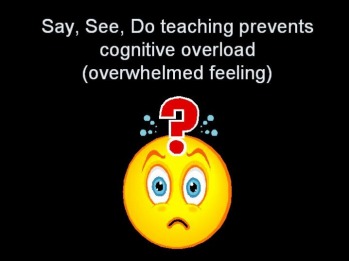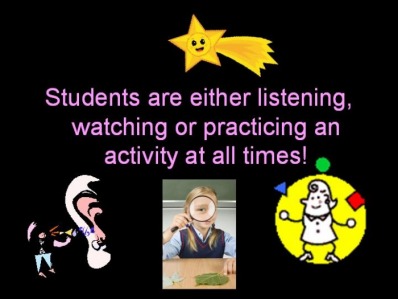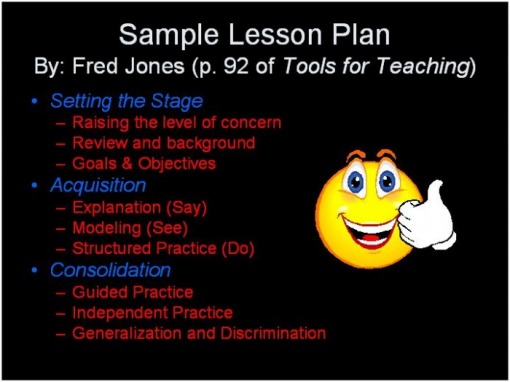Say, See, Do Teaching

As part of lesson management, the concept of Say, See, Do teaching is very helpful.
Description:
Say, See, Do teaching is one of the processes used to create independent and self-controlled learners. It does this through the utilization of three different parts of the brain to cement concepts into memory. The brain is only designed to handle so much input before it tunes out. Therefore, in the traditional style of teaching, there is much “tune out” that can lead to misbehavior. It is essentially, input, input, input, input, output. Say, See, Do teaching changes this model to input, output, input, output… By chunking material and having students demonstrate it, there are fewer overloads. Step one is Say. This is the explaining portion. As seen in lesson management, it is crucial for this to be clear and concise. After teaching one concept, model it for the students (See). Finally, have them practice it as well (Do). (Jones, 2007).
Significance:
In this style of teaching, students are engaged in wither listening, watching or doing, and therefore less likely to misbehave. Plus, it works naturally with the brain so students are able to retain more information. Additionally, it combines all types of learning, thus reaching a greater number of students.
Demonstration:
A class is learning how to throw a Frisbee for physical education. The teacher begins with showing how to hold the Frisbee. He indicates that the last three fingers are placed on the underside of the Frisbee, while the thumb goes on the top. The index finger is placed on the side of the Frisbee where there is a curved edge. He then models this. Students proceed to practice. When they have correctly mastered this task, the teacher moves on to the stance required for throwing a Frisbee. This lesson continues until all students are comfortable with this.
Integral Components:
A pivotal point to remember in this concept is to walk through slowly. Instruction is designed for all students to understand completely. Therefore the teacher needs to take his or her time explaining the concept so that practice is effective. Because this is so different than regular teaching, Fred Jones has included a sample lesson guide to aid in teachers’ planning. He begins by setting the stage. This is the introduction where the teacher, “raises the level of concern, reviews the background, and looks at goals and objectives” (Jones, 2007). He then moves on to the acquisition of the lesson, characterized by Say, See, Do. After this has been mastered, the lesson moves into consolidation. This includes guided practice, independent practice, and generalization and discrimination. (Jones, 2007) Using this template with the tips in lesson planning can create an effective lesson tailored for all students.
Individualization:
This concept is vastly different than the traditional style of teaching. Though it may take some initial getting used to, I look forward to incorporating it into my own classroom. As a kinesthetic learner, I always appreciated any sort of learning where there was an action or tangible product involved. Yet, from my observations, it appears as though virtually every student, regardless of learning style appreciates this as well. So often learning consists of little action, however, and as a teacher I plan to teach my students in this more natural way.
Spiritual Application:
Because the Say, See, Do teaching method is vastly different than traditional instruction, it can be a bit frustrating at first. Breaking each portion into smaller sections may try one’s patience. However, as Christians, we are called to exhibit patience in all areas of life. Ecclesiastes 7:8-9 is just one verse that illustrates this. In it, Solomon states that patience is better than pride and that “anger resides in the lap of fools” (Ecclesiastes 7:8-9). Modeling patience is not only critical to us as Christians, but models this to students as well.



